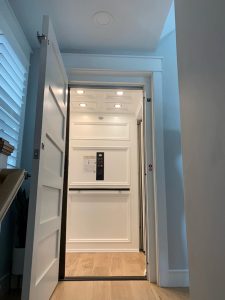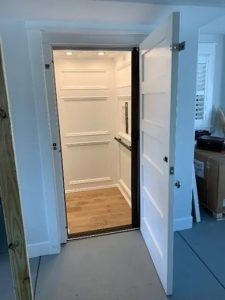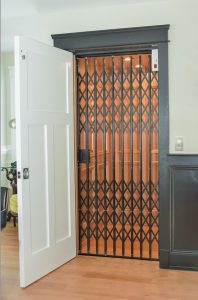
Designing your own in-home elevator can be an exciting and rewarding project. It’s an opportunity to blend functionality with personal style, creating a lift system that not only enhances your home’s accessibility but also complements its aesthetic. The following article discusses how to navigate the design process and make informed choices for your home elevator.
Selecting the Right Openings
The first step in designing your elevator is deciding on the type of openings that best suit your home and lifestyle:
Single Opening: Ideal for compact spaces where the elevator serves a single entry point. This option is great for smaller homes or where a simple solution is needed.
Two Opening Walk-through: This design allows passengers to enter and exit from different sides, making it convenient for homes with more space and high traffic areas.
Two Opening Corner Post: For a more spacious option, the two opening corner post design provides two access points from adjacent walls, perfect for corner installations and enhancing a home’s accessibility.
Choosing Your Style
The style of your elevator should harmonize with the overall design of your home. Here are some popular styles to consider, offered by Accredited Home Elevator Company:
Bristol: A classic choice that combines timeless elegance with functionality.
Longport: Modern and sleek, this style is perfect for contemporary homes.
Avalon 3 Panel: Offers a refined look with three panels, balancing sophistication and simplicity.
Avalon 4 Panel: An upgraded version with four panels, providing a more expansive view and a touch of luxury.
Shaker: Characterized by its clean lines and minimalist design, ideal for those who appreciate understated elegance.
Wood and Finish Options
Selecting the right wood and finish is crucial for matching your lift system with your home’s interior. The wood choice should reflect your personal style while complementing the existing décor. Finishes add a layer of protection and enhance the wood’s natural beauty. Common choices include rich mahogany, warm oak, and sleek walnut.
Designing the Wall and Ceiling
The interior of your lift system should be as stylish as it is functional. For walls, options range from polished wood panels to textured finishes. The ceiling design can incorporate materials such as:
Wood Paneling: Adds a warm, classic touch.
Glass Panels: Creates a modern, open feel.
Custom Designs: Tailored to fit your unique taste and the aesthetic of your home.
Lighting Choices
Proper lighting also enhances the functionality and ambiance of your elevator. You can choose from several lighting options, including:
Stainless LED Light: Offers a clean, contemporary look with bright illumination.
Brushed Brass LED Light: Adds a touch of sophistication with a warm, golden glow.
Black Matte Bronze LED Light: Ideal for a sleek, modern aesthetic.
White LED Light: Provides a neutral, versatile lighting option that fits any décor.

Selecting Handrails
Handrails are both functional and decorative. They ensure safety while adding a personal touch. Some popular options include:
Brass (Round): Classic and elegant.
Black Matte Bronze (Round): Modern and stylish.
Brushed Stainless (Round): Sleek and durable.
Brushed Stainless (Flat): Offers a contemporary look with a sturdy design.
Choosing Fixtures
Fixtures can also enhance the functionality and aesthetic of your elevator. Consider the following for a modern approach:
Flat Stainless Steel: Durable and modern.
Brushed Brass: Adds a touch of luxury and warmth.
Black Matte Bronze: For a sleek, modern finish.
Position Indicator
Deciding whether to include a position indicator can add an extra layer of convenience. This feature shows the current floor of the elevator, making it easier to track its location.
Gate Options
Additionally, choosing the right gate is essential for both safety and style. Options include:
Accordion Gate: Available in various colors and materials, including white, black, and clear acrylic.
Scissor Gate (Manual Only): Comes in black, silver, or white.
2 Speed Side Slide Doors: Options include glass, stainless steel, black, or white.
3 Speed Side Slide Doors: Similar options as the 2-speed, with added speed for larger elevators.
Automatic Gate: Provides added convenience and ease of use.
Bringing It All Together
When designing your in-home elevator, it’s important to consider how each element will work together to create a cohesive and functional space. Think about how the style, materials, and features will complement the existing design of your home. Collaborate with design professionals like Accredited Home Elevator to ensure that your vision is realized and that all elements are seamlessly integrated.
Conclusion
Designing your dream in-home, personal elevator is an opportunity to enhance your home’s functionality and accessibility while also reflecting your personal style. By carefully selecting options for openings, styles, materials, and features, you can create a custom lift system that meets your needs and adds value to your home. Whether you’re updating an existing elevator or installing a new one, attention to detail and thoughtful design will ensure that your elevator is both practical and beautiful.
Ready to start your elevator design journey? Explore your options and work with experts to bring your vision to life. Elevate your home experience with a custom-designed elevator that truly stands out.



